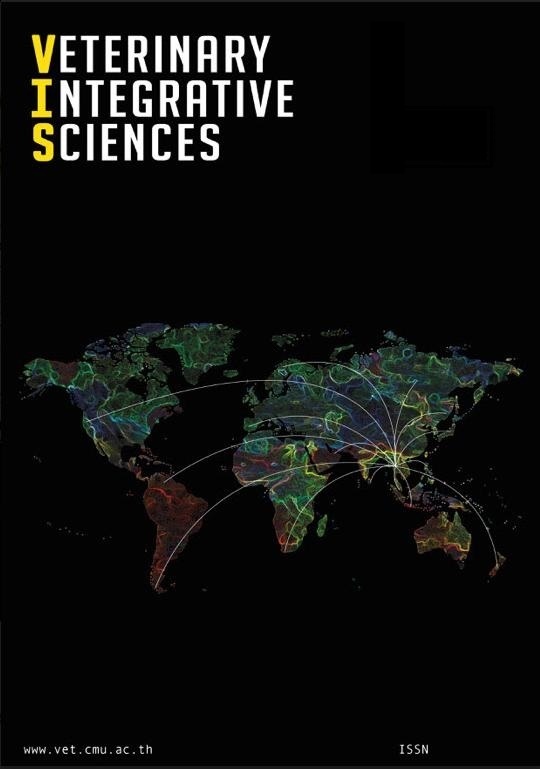Antimicrobial effect of Japanese pumpkin (Cucurbita maxima) extract on local mastitis pathogen
Main Article Content
Abstract
In Chiang Mai, Thailand, evidence of a high prevalence of bacterial mastitis with antimicrobial resistance has been observed over the past decade. The development of applicable alternative medicine options is needed to address this resistance situation. The crude extraction of natural resources, such as Japanese pumpkin, should be studied for bacterial activity so as to raise the economic value of each substance. The objective of this study was to explore the antimicrobial activity of Japanese pumpkin by-products against bacteria that has caused dairy mastitis to circulate in the Chiang Mai area. Crude polysaccharides and carotenoids were extracted from Japanese pumpkins. Subsequently, 55 isolates of 10 bacterial species were collected from mastitis milk samples obtained from dairy farms in Chiang Mai during August to October, 2018 were screened for antimicrobial activity using the disc diffusion method. Nine bacterial species displaying inhibition zones were then explored to determine the minimum inhibitory concentrations (MICs). Consequently, 300 mg/ml of crude polysaccharide extracts were not found to be able to inhibit most bacteria. However, the MICs of crude carotenoid extracts ranged from 75 to 300 mg/ml. In summary, by-products of the pumpkin extraction displayed effective antimicrobial activity. Thus, these by-products offer an alternative in preventing the bacteria causing mastitis. This indicates the possibility of developing a prototype of teat dip for the prevention of outbreaks of bacterial infections in the future among dairy cattle. Additionally, this approach could increase the potential value of a large amount of waste produced during the course of industrial processing.
Article Details

This work is licensed under a Creative Commons Attribution 4.0 International License.
Publishing an article with open access in Veterinary Integrative Sciences leaves the copyright with the author. The article is published under the Creative Commons Attribution License 4.0 (CC-BY 4.0), which allows users to read, copy, distribute and make derivative works from the material, as long as the author of the original work is cited.
References
Bi, Y., Wang, Y. J., Qin, Y., Vallverdú, R. G., García, J. M., Sun, W., Li, S., Cao, Z. 2016. Prevalence of Bovine Mastitis Pathogens in Bulk Tank Milk in China. PLoS One. 11, e0155621. https://doi.org/10.1371/journal.pone.0155621
Boonyayatra, S., Wasana Chaisri. 2004. Incidence and prevalence of subclinical mastitis in small holder dairy farms of Chiang Mai province, Thailand. Chiang Mai Vet. J. 2, 25-30.
Bradley, A. 2002. Bovine mastitis: An evolving disease. Vet. J. 164, 116–128.
Chaisri, W., Okonogi, S., Kreausukon, K., Pinyopummintr, T., Suriyasathaporn, W. 2010. Effects of medium and high discomfort periods during dry environment on either pathogens causing subclinical mastitis or antimicrobial resistance of environmental Streptococci and coagulase-negative Staphylococci. CMU.J.Nat.Sci. 9, 217-230.
Cheng, G., Hao, H., Xie, S., Wang, X., Dai, M., Huang, L., Yuan, Z. (2014). Antibiotic alternatives: The substitution of antibiotics in animal husbandry? Front. Microbiol. 5. https://doi.org/10.3389/fmicb.2014.00217
Devine, D. A., Hancock, R. E. W. 2002. Cationic peptides: Distribution and mechanisms of resistance. Curr. Pharm. Des. 8, 703–714.
Gu, C., Pan, S. 2017. Extraction, purification and antibacterial activity of polysaccharides from Purslane. Adv. Eng. Res. 129, 734-740. https://doi.org/10.2991/iceesd-17.2017.135
Karpiński, T. M., Adamczak, A. 2019. Fucoxanthin—An Antibacterial Carotenoid. Antioxidants. 8. https://doi.org/10.3390/antiox8080239
Keceli, T., Erginkaya, Z., Turkkan, E., Kaya, U. 2013. Antioxidant and Antibacterial Effects of Carotenoids Extracted from Rhodotorula glutinis Strains. Asian J. Chem. 25, 42–46.
Kossaibati, M. A., Esslemont, R. J. 1997. The costs of production diseases in dairy herds in England. Vet. J. 154, 41–51.
Molla, B., Miko, A., Pries, K., Hildebrandt, G., Kleer, J., Schroeter, A., Helmuth, R. 2007. Class 1 integrons and resistance gene cassettes among multidrug resistant Salmonella serovars isolated from slaughter animals and foods of animal origin in Ethiopia. Acta Trop. 103, 142–149.
Nobrega, D. B., De Buck, J., Barkema, H. W. 2018. Antimicrobial resistance in non-aureus staphylococci isolated from milk is associated with systemic but not intramammary administration of antimicrobials in dairy cattle. J. Dairy Sci. https://doi.org/10.3168/jds.2018-14540
Nobrega, D. B., Naushad, S., Naqvi, S. A., Condas, L. A. Z., Saini, V., Kastelic, J. P., Luby, C., De Buck, J., Barkema, H. W. 2018. Prevalence and Genetic Basis of Antimicrobial Resistance in Non-aureus Staphylococci Isolated from Canadian Dairy Herds. Front. Microbiol. 9, 256. https://doi.org/10.3389/fmicb.2018.00256
Oliver, S. P., Murinda, S. E. 2012. Antimicrobial resistance of mastitis pathogens. Vet. Clin. North Am. Food Anim. Pract. 28, 165–185.
Pérez, M. J., Falqué, E., Domínguez, H. 2016. Antimicrobial Action of Compounds from Marine Seaweed. Mar. Drugs. 14. https://doi.org/10.3390/md14030052
Qian, Z.-G. 2014. Cellulase-assisted extraction of polysaccharides from Cucurbita moschata and their antibacterial activity. Carbohydr. Polym. 101, 432–434.
Shanmugam, A., Mahalakshmi, T., Vino, B. 2008. Antimicrobial Activity of Polysaccharide Isolated from the Cuttlebone of Sepia aculeata (Orbingy, 1848) and Sepia brevimana (Steenstrup, 1875): An Approach to Selected Antimicrobial Activity for Human Pathogenic Microorganisms. J. Fish. Aquat. Sci. 2, 268–274.
USDA APHIS. United States Department of Agriculture, Animal Plant Health Inspec- tion Service National Animal Health Monitoring System. Antibiotic use on U.S. dairy operations, 2002 and 2007. Available at: http://nahms.aphis.usda.gov/dairy/index. htm#dairy2007. Accessed January 28, 2019.
Watts, J. L. 1988. Etiological agents of bovine mastitis. Vet. Microbiol. 16, 41–66.
Yolmeh, M., Hamedi, H., Khomeiri, M. 2016. Antimicrobial Activity of Pigments Extracted from Rhodotorula glutinis Against Some Bacteria and Fungi. Zahedan. J. Res. Med. Sci. https://doi.org/10.17795/zjrms-4954
Zhang, Y., Wu, Y.-T., Zheng, W., Han, X.-X., Jiang, Y.-H., Hu, P.-L., Tang, Z.-X., Shi, L.-E. 2017. The antibacterial activity and antibacterial mechanism of a polysaccharide from Cordyceps cicadae. J. Funct. Foods, 38, 273–279.

